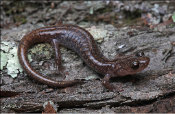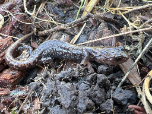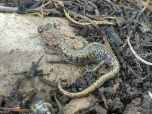Sacramento Mountains Salamander (Aneides hardii)
Description: Aneides hardii is a plethodontid salamander from south-central New Mexico, with a snout-vent length ranging from 40 to 58 mm. Females are typically smaller than males, having an average snout-vent length of 44.5 mm compared to 48.4 for males. Total length ranges from 25.5 to 100.7 mm, with tails being slightly shorter than the snout-vent length. In males especially, the temporal region on the head is enlarged by the jaw muscles. The trunk and tail are round. There are 14 or 15 costal grooves, with 2 to 4.5 between appressed limbs. The digits are short, with four digits in each forelimb and five in each hind limb. The toe tips are somewhat rounded. In life, the dorsum is blackish-brown or brown with greenish-gray to bronze mottling and gold flecks
Habitat: It typically occurs on north or east facing slopes among Douglas fir, Engelmann spruce and white fir, often with an understory of Rocky Mountain maple. It often hides in the leaf litter or rotten logs, under rocks, fallen branches or vegetation. Above the tree line it is found in stony areas with mosses and lichens.
Range: The Sacramento Mountain salamander occurs in three separate mountainous areas in New Mexico, the Capitan Mountains, the Sierra Blanca range and the Sacramento Mountains. It is found at heights of at least 7,900 feet above sea level in mixed forests.
Found in these States:
NM
Diet: The Sacramento Mountain salamander feeds on small invertebrates such as ants, rove beetles, springtails, snails and spiders.
Reproduction: Breeding takes place in the summer with eggs being laid in small clutches inside rotten logs and stumps and also possibly in underground cavities. The larvae undergo direct development in the eggs with fully formed miniature salamanders hatching out measuring about 0.47 inches in snout to vent length.
Status: Listed as Near Threatened because its extent of occurrence (EOO) is 20,700 km2, it likely occurs in ten or fewer threat-defined locations, and there is continuing decline in the extent and quality of its habitat, thus making the species close to qualifying for Vulnerable.
»» Kingdom: Animalia - Animals
»» Phylum: Chordata - Chordates
»» Subphylum: Vertebrata - Vertebrates
»» Class: Amphibia - (Amphibians)
»» Order: Caudata - Salamanders
»» Family: Plethodontidae - Lungless Salamanders
»» Genus: Aneides
»» Species: Aneides hardii - Sacramento Mountains Salamander
This article uses material from the Wikipedia article "Sacramento Mountains Salamander", which is released under the Creative Commons Attribution-Share-Alike License 3.0. Content may have been omitted from the original, but no content has been changed or extended.
|












